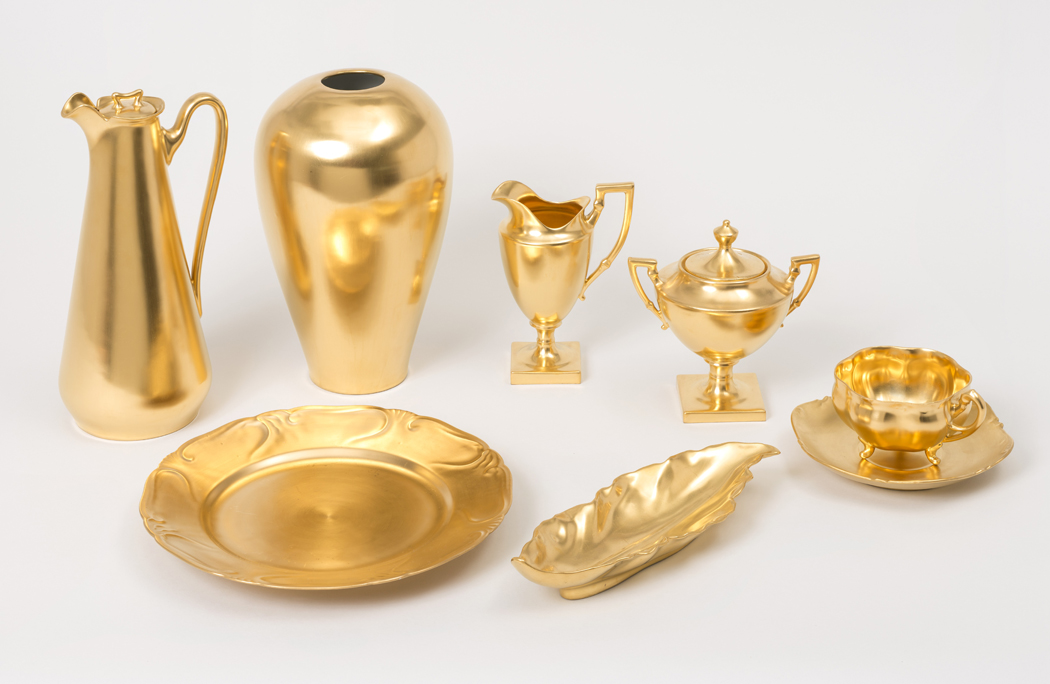In the early 1890s science teacher Emily Healey was working in her laboratory in Washington D.C. when she accidently dropped a certain uranium salt into some heavy oil. When she fired this compound onto a scrap of china, the effect was a brilliantly colored surface. Many experiments with the uranium followed and Emily determined that a unique and predictable colored effect could be achieved when this uranium was mixed with gold and when fixed on porcelain, a beautiful luster surface materialized. This “chryso” or gold technique, a revival of an ancient Chinese enameling process, was the stimulus for the founding of Chryso-Ceramics, Emily and her sister Mary’s thriving ceramics decoration business at the turn of the twentieth century.
While gold accents had long been used to accentuate shape and decoration in ceramics, Emily and Mary innovated by covering porcelain forms entirely in gold therefore producing an overall metallic appearance. The Healeys did not make the base ceramics themselves; their handiwork only resided in the gold decoration. The sisters purchased blanks of the highest quality from a range of leading manufactures, including Berlin, Worcester, Limoges, and Belleek, to ensure a purely smooth surface. In an 1894 article on these Chryso-Ceramics, one arts journalist remarked that “the products of all the most famous potteries are sought and utilized, becoming in their new dress a something quite novel.” [1] The Cooper Hewitt’s group of these tablewares evinces the sisters’ use of disparate ceramics; this group contains shapes ranging from a classical urn to plates with art nouveau flourishes. Their gold surface affords them stylistic unity.
The first sizeable shipment of the wares occurred in February of 1892. A small factory, employing fifteen women, operated from 9AM to 4:30PM at 1122 Connecticut Avenue in Washington, D.C. The sisters sold the wares independently and consumers could also purchase the tablewares at first class jewelers such as Tiffany & Co. In 1893 the Healey sisters exhibited these chryso-ceramics to great acclaim in three exhibits at the World’s Columbian Exposition in Chicago, the most dramatic of which was an all-white pavilion in the Manufactures Building. The luxurious finish belied the wares’ practicality. The World’s Columbian Exposition catalog noted that “The gold used in this china decoration is warranted pure, very durable, retains its luster and quality, and is easily cleaned.” [2]
[1] J.H. Chadwick, “Chryso-Ceramics,” Art Interchange, April 1894, 109.
[2] Moses P. Handy, World’s Columbian Exposition, 1893 Official Catalogue (Chicago: W.B. Conkey Co., 1893), 25.
Emily Orr is Assistant Curator of Modern and Contemporary American Design at Cooper Hewitt, Smithsonian Design Museum.

3 thoughts on “Healey Sisters Strike Gold”
Cindy peters on August 7, 2018 at 10:34 am
Could you please tell me some information on a Heatley gold dish I have that is marked with a #1489
Janet Melcher on August 29, 2020 at 7:21 pm
Could you give me some information on the Healey Gold leaf dish marked 1674? It is almost 12” long and is just beautiful. Is it antique? I wonder how I might learn of its value.
martina on July 1, 2021 at 7:22 pm
Emily, does the use of Uranium salt in achieving the effect mean that that the pieces are radioactive?